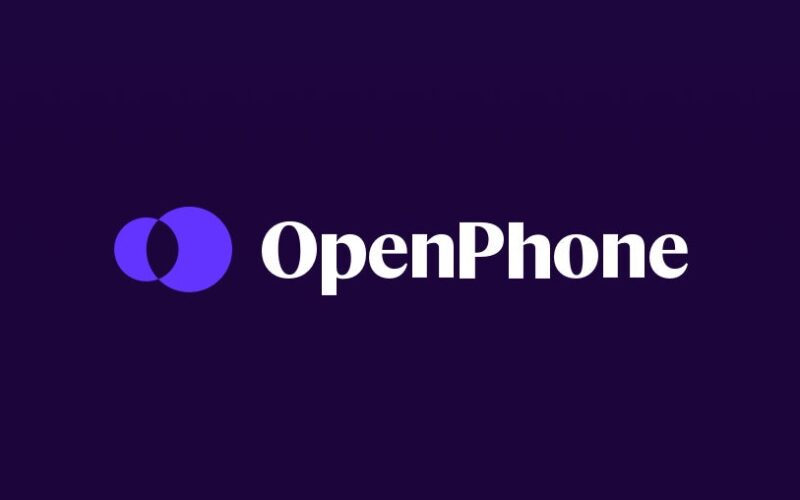OpenPhone’s fast factsStarting price: $15 per user per month. Key features:
|
OpenPhone shines for its unlimited messaging, shared environment and built-in contact management for small teams. It’s the VoIP phone system I ultimately ended up buying for my team because it was affordable and easy to set up, had just enough functionality and didn’t require us to buy any new devices.
However, it’s missing a lot of standard features you’ll get elsewhere and it’s not particularly great at scale.
OpenPhone’s pricing
OpenPhone’s pricing is very straightforward. There are three plans to choose from, with just a couple of miscellaneous fees and add-ons.
- Starter: Starts at $15 per user per month.
- Business: Starts at $23 per user per month.
- Enterprise: Custom quote.
The rates above reflect annual billing, with a 30% discount at the Business tier and a 21% discount at the Starter level. Month-to-month pricing is also available, and you can try OpenPhone for free with a seven-day trial.
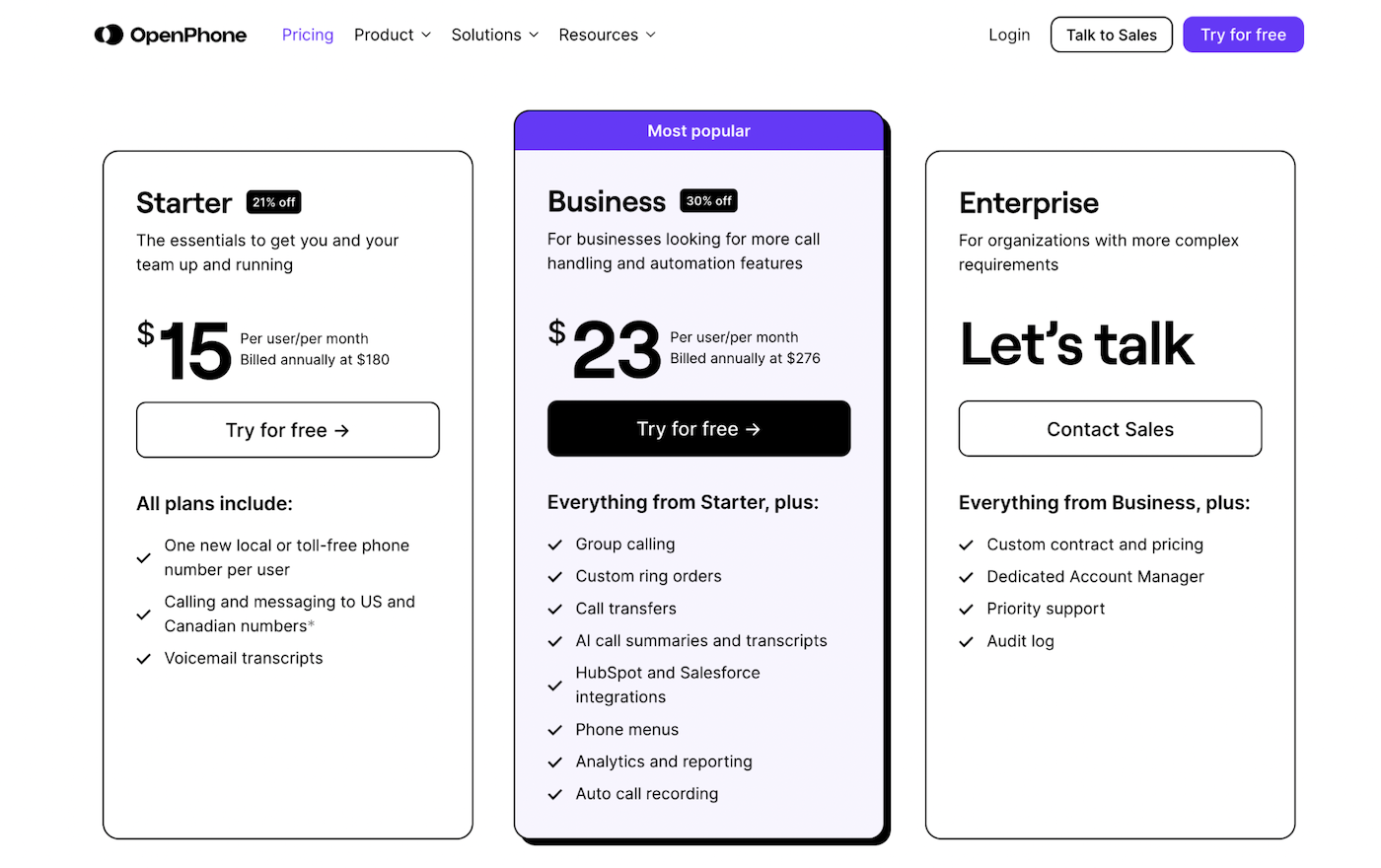
My team uses the Business plan; while slightly more expensive, it gives you what you need to manage calls as a company. Beyond the basics, you’ll also get automatic call recording, AI-generated call summaries and integrations for HubSpot and Salesforce.
If you want to use business texting, there’s an industry-wide $19 one-time setup fee and an ongoing monthly messaging fee ranging from just $1.50 to $3.
Every provider charges these or bundles them into the monthly fee you pay, so this isn’t unique to OpenPhone.
Additional phone numbers cost $5 per month, and you can set up automated messages through Zapier for $0.01 per outgoing text. International calling and messaging are based on usage and vary by country.
OpenPhone’s key features
While most of OpenPhone’s features are fairly basic, it’s a solid platform with some noteworthy standouts. You’ll benefit from unlimited calling, unlimited texting, shared phone numbers, contact management tools and even a couple of AI-powered capabilities.
Unlimited calling and messaging
OpenPhone delivers unlimited calling and text messaging within the U.S. and Canada. This is a pretty good value for the price.
You’re also getting one new local or toll-free number with every user that you onboard, so everyone can have their own line.
In terms of calling, you can dial out and receive incoming calls, but there aren’t many bells and whistles. Manual recording, voicemail transcription and manual call recording are the only three features you’re really getting unless you upgrade.
Beyond the entry-level tier, you’ll unlock an IVR phone menu, group calls, call holds, warm transfers and ring orders.
The unlimited texting capabilities definitely shine above the calling options. You can set up a bunch of automated text triggers based on different customer interactions and even schedule outbound messages in advance.
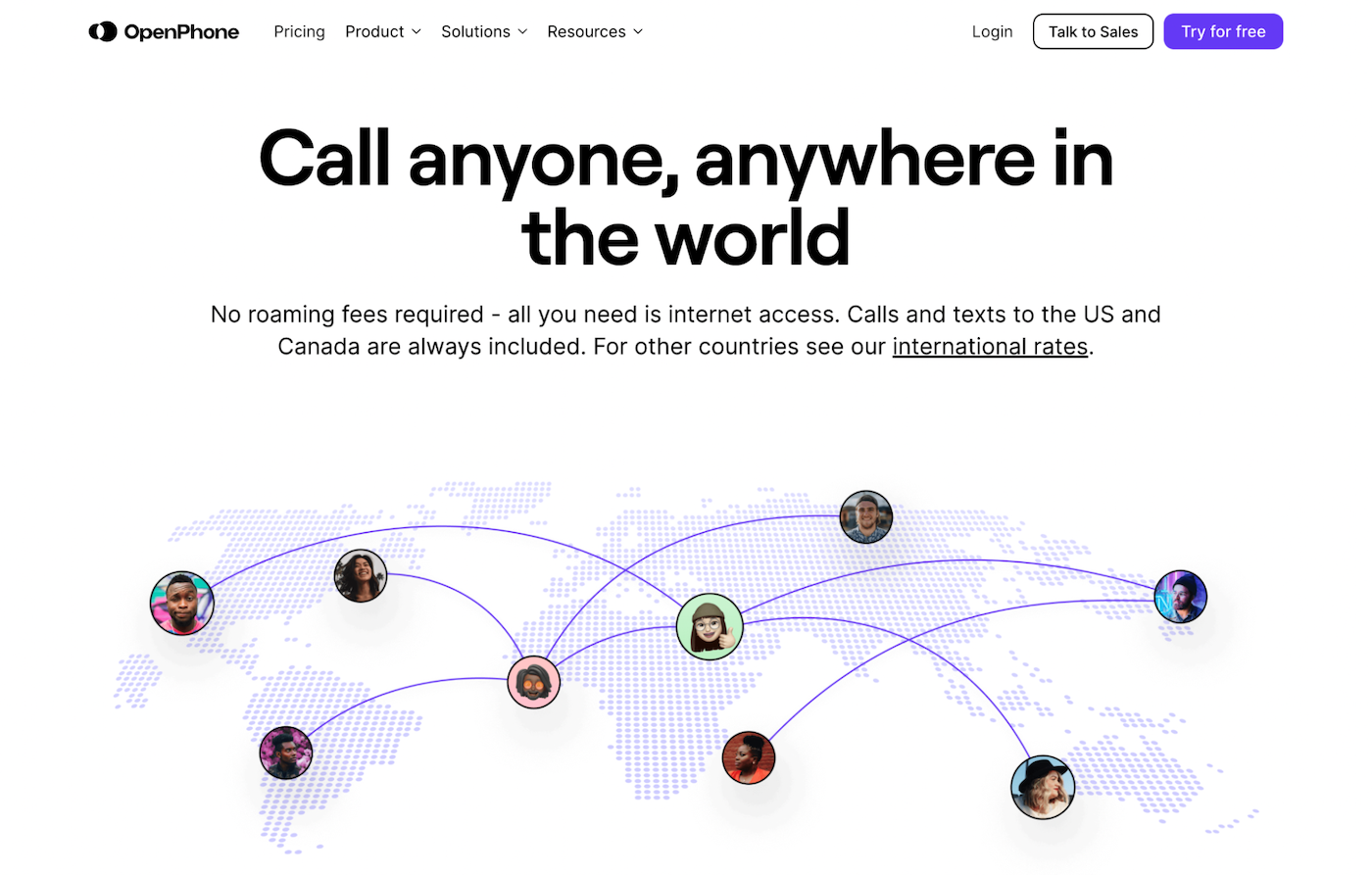
Shared phone numbers
Sharing a phone number with a team may sound weird, but it’s actually really practical for OpenPhone’s messaging capabilities.
Let’s say a support rep was texting with a customer on Monday. That customer may reply to the same text thread on Tuesday when the original rep is out sick or on a lunch break. But with the shared number, someone else on your team can quickly pick up where the first person left off.
On the recipient side, the transition is seamless, and they never actually know that they’re dealing with more than one person.
This feature helps you provide better and faster responses via text as part of a collaborative team effort.
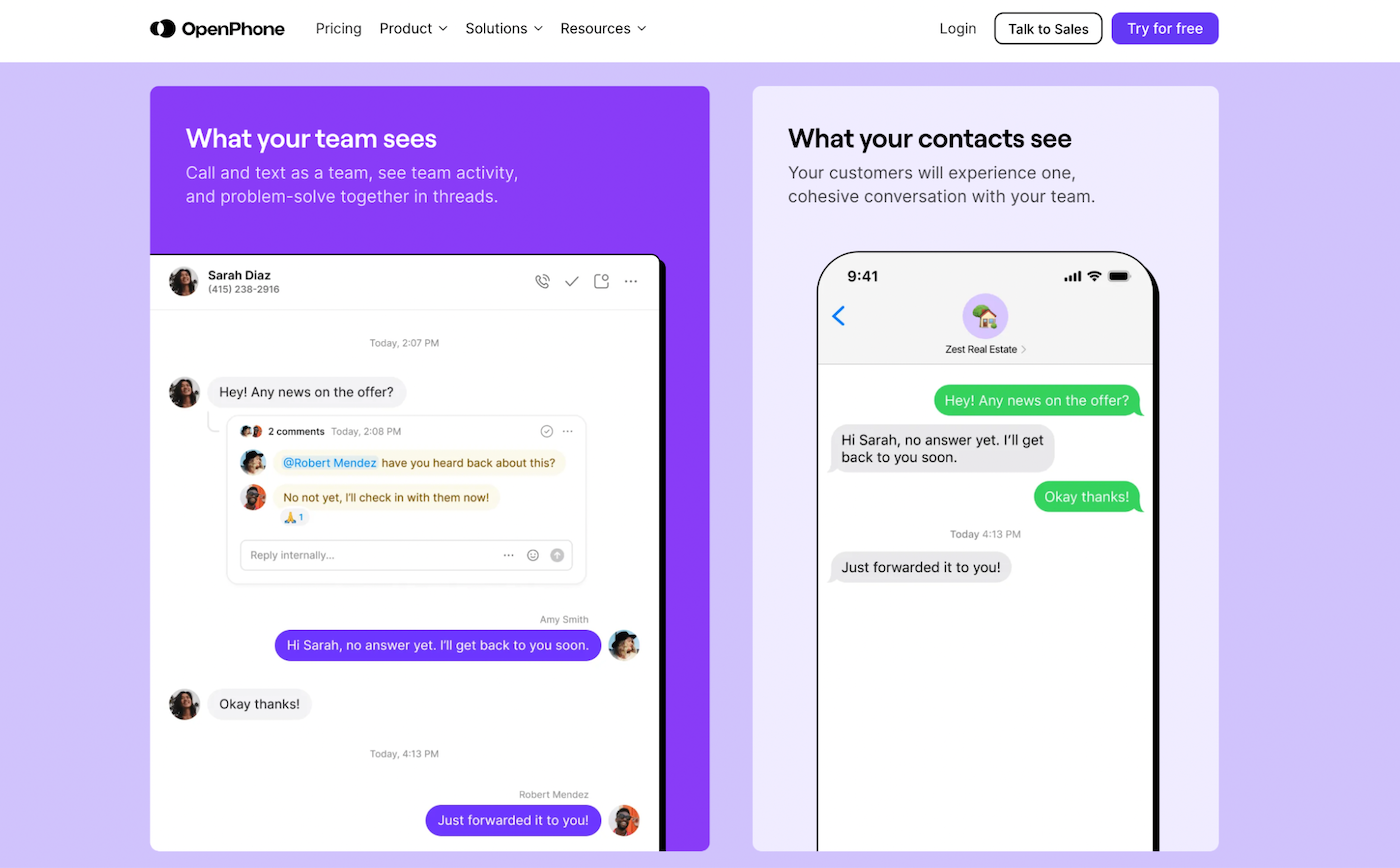
AI-suggested message responses
You can enable OpenPhone’s built-in AI to automatically generate two or three replies to every inbound message. It’s a really cool feature that helps make your team more productive, and they can just quickly click a relevant reply within seconds of getting a text.
This feature is available to all OpenPhone users. This is a good sign the platform is adapting to the latest AI trends, which are all the buzz right now in the business communications space.
If you like this feature, you can also experiment with asking OpenPhone’s AI to generate outbound messages for you.
Then, you can send them as is or edit them before blasting sending.
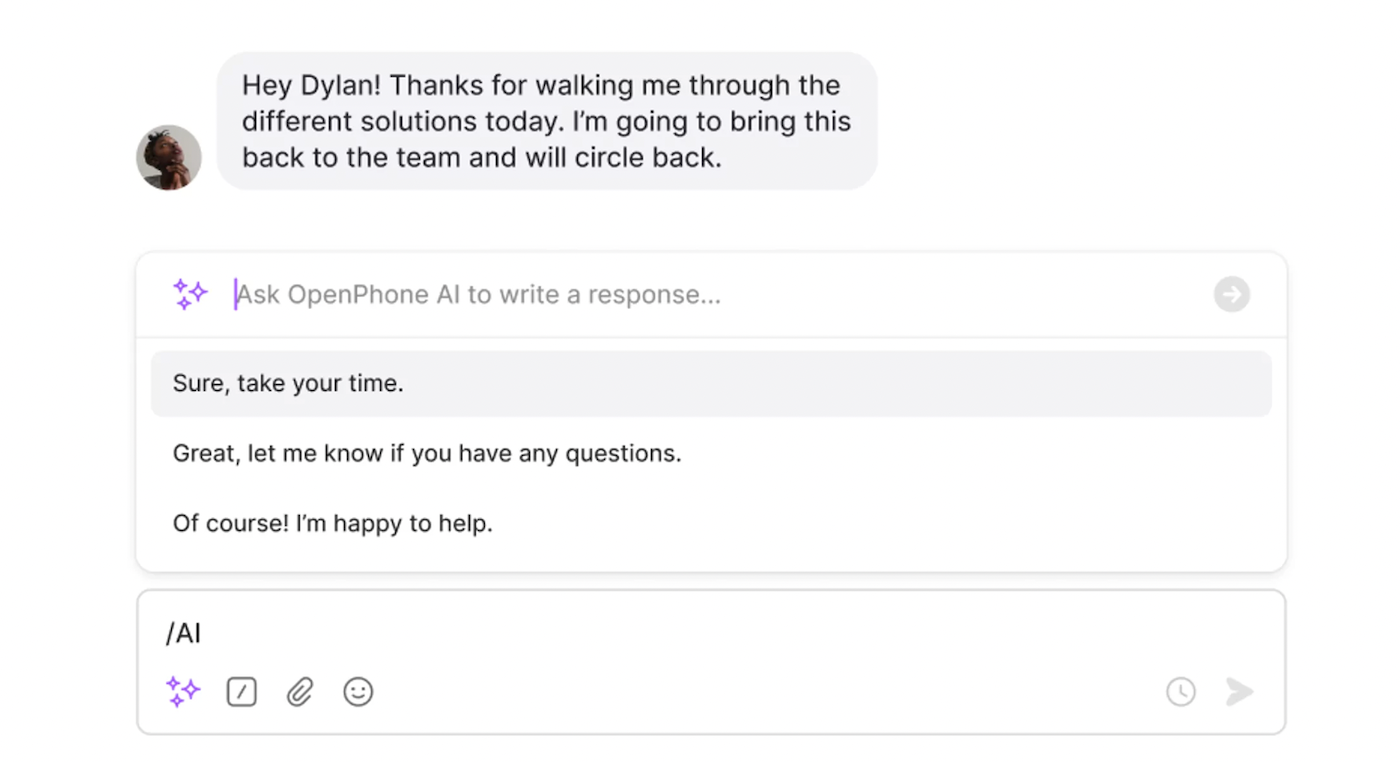
Built-in contact management
OpenPhone has a lightweight CRM that’s built into the platform. It’s a place for you to add someone’s contact information and relevant notes, tags and other details about the person for everyone on your team to see. Calling this a CRM is generous, but it’s fine for basic contact management.
The feature also helps ensure you won’t have duplicate contacts across shared numbers, and you can share specific contact information with other teammates without having to copy/paste or rely on manual entry.
In addition to adding new contacts directly in OpenPhone, you can also import contacts as a CSV or integrate your Google Contacts.
HubSport, Salesforce and Gong integrations are available on select plans.

AI call summaries and transcripts on select plans
If you’re on a Business plan or higher, you’ll get AI-generated summaries and full transcripts for every call.
This is a handy way to quickly reference something that happened during a longer call without having to sit through an entire recording.
It also helps you stay present during calls. Instead of rapidly taking notes while half-listening to what someone is saying, you can stay engaged knowing that AI is taking notes for you.
Teams can share these summaries with people who missed a meeting or call, helping them get up to speed quickly without a complete briefing.
OpenPhone pros
- Simple and user-friendly interface.
- Strong messaging features.
- Collaborative environment.
- Shared inbox, contacts and numbers.
- Rules-based triggers to build automations.
- Lightweight and simple if you don’t need a lot.
- Very easy to set up.
- Daily database backups.
- Solid customer service.
- Free 7-day trial.
OpenPhone cons
- Only includes basic phone features.
- Analytics is only on the top two plans.
- Not much room to scale.
- Limited integrations and no API (coming soon).
Alternatives to OpenPhone
After looking into dozens of options, I bought OpenPhone for my team, which still uses it today. Despite that, it’s not what I recommend in most situations. Here’s a look at how OpenPhone compares to my top choices.
| OpenPhone | Nextiva | RingCentral | 8×8 | Dialpad | |
|---|---|---|---|---|---|
| Starting price | $15 per user per month | $28.95 per user per month | $20 per user per month | Custom quote | $15 per user per month |
| Free trial | 7 days | Demo only | 14 days | No | 14 days |
| Setup | Very easy | Easy | Complex | Complex | Easy |
| Mobile app | Great | Average | Great | Average | Good |
| Call routing | Average | Average | Advanced | Average | Advanced |
| Call recording | All plans | Top plan only | All plans | Call center only | All plans |
| Integrations | 6 + Zapier | 20+ | 300+ | 65+ | 70+ |
| AI features | Average | Average | Advanced | Basic | Advanced |
| Texting | Yes | Some plans | Yes | Yes | Yes |
| Video meetings | No | Yes | Yes | Yes | Yes |
| Team chat | No | Yes | Yes | Yes | Yes |
| Online fax | No | Yes | Some plans | Yes | + $10 per month |
Nextiva

Nextiva is a more well-rounded business communications solution. It comes with everything you need to talk to customers and each other, including team chat, video conferencing, voice, texting and faxing. With new customer discounts and an annual plan, it comes out to just a few dollars more per month than OpenPhone, but with way more functionality. To learn more, read my review of Nextiva.
RingCentral

Where Nextiva and OpenPhone are simple and easy to use, RingCentral goes the opposite direction. It offers just about every communications and call center feature you can imagine. To learn more, read my review of RingCentral.
8×8

If you handle a lot of international calls, 8×8 can’t be beat. With plans that allow for unlimited calls to 14 or 48 countries, it’s a much better deal for high-volume than paying per minute. Plus, it includes every communication channel on every plan, even the cheapest ones. To learn more, read my review of 8×8.
Dialpad

Dialpad and OpenPhone are both newer cloud-first phone systems. OpenPhone is simple, while Dialpad offers more advanced capabilities and AI functionality for call centers and sales teams. It has standard phone systems, too, but they include more communication channels than OpenPhone.
Methodology
I researched and reviewed OpenPhone using the same core criteria as other business communication solutions, including:
- Standard and advanced features: We assess the basics you need, plus the advanced features that boost your performance. Some of the standard features we look for include video conferencing, SMS/MMS messaging, voicemail, automated call forwarding, device flipping and mobile/desktop apps.
- Customer support: How can you get support, and what are the support hours? We also look at the helpfulness of the platform’s customer support and note any positive reviews.
- Third-party integrations: The best phone systems seamlessly sync with third-party business apps, like CRMs, ERP software, faxing tools, SMS platforms, cloud storage systems and more.
- Security and privacy: We look at the redundancy architecture, advanced encryption standards, authentication options, advanced management options, data center audits, server locations — anything that’s tied to keeping your calls safe and data secure.
- Uptime percentage: Anything that could cause unplanned downtime, outages, service interruptions or lead to delays due to the technical setup or platform infrastructure.
- Demo or free trial: Can you test or try the platform before you buy it?
- Overall cost: Fees, plan options, pricing differences between monthly or annual billing, installation fees, cost per user, etc.
Source link
lol

